ZnO-CuO Nanocomposite as an Efficient Adsorbent for As(III) Removal from Water
Abstract
:1. Introduction
2. Materials and Methods
2.1. Materials
2.2. ZnO-CuO Nanocomposites Synthesis
2.3. Characterization
2.4. Batch Adsorption Experiments
2.5. Impact of pH on Arsenic Removal
2.6. PZC of ZnO-CuO Nanocomposite
2.7. Influence of Coexisting Ions on Arsenic Removal
3. Results and Discussion
3.1. X-ray Diffraction Results
3.2. FTIR Spectral Analysis
3.3. Scanning and Transmission Electron Microscopy
| Element | Sample | ||||
|---|---|---|---|---|---|
| ZnO (100) | ZnO-CuO (25:75) | ZnO-CuO (50:50) | ZnO-CuO (75:25) | CuO (100) | |
| Zn (Atom %) | 30.42 | 5.85 | 15.93 | 19.95 | - |
| Cu (Atom %) | - | 20.33 | 17.00 | 6.07 | 27.46 |
| O (Atom %) | 19.79 | 60.24 | 57.04 | 59.69 | 61.32 |
| C (Atom %) | 49.79 | 13.58 | 10.03 | 14.29 | 11.21 |
3.4. Analysis of Arsenic (III) Adsorption
3.5. pH Influence on Arsenic (III) Removal
| Material | Synthesis Method | Test Conditions | qmax (mg/g) | Reference |
|---|---|---|---|---|
| ZnO-CuO/g-C3N4 | Solution combustion method | 7 mg of adsorbent; 50 mL of 20–150 ppb As (III) solution; 70 min | 97.56 | [46] |
| CuO-ZnO | Electrospinning | 5 mg of adsorbent; 10 mL of 1–9 ppm As (III) solution; 24 h | 26.27 | [44] |
| ZnO-GO | Solvothermal | 0.3 g of adsorbent; 100 mL of 10–50 ppm As (III) solution; 1 h. | 8.17 | [82] |
| CuO-ZnO doped chitosan succinic acid | Freeze-drying process | 10 mg of adsorbent; 5 mL of 0.1–1.2 ppm As (III) solution; 24 h. | 0.899 | [84] |
| ZnO | Precipitation | 10 mg of adsorbent; 4 mL of 3–1000 ppm As (III) solution | 5.03 | [81] |
| ZnO nanorods | Precipitation | 0.4 g of adsorbent; 50 mL of 30–90 ppb As (III) solution | 38.46 | [85] |
| Pd@ZnO/CuO | Citrate-hydrothermal | 10 mg of adsorbent; 10 mL of 250 ppb arsenic solution; 3 h | 91.96 | [83] |
| CuO/ZnO | Ultrasound | 50 mg of adsorbent; 100 mL of arsenic solution with 10–100 ppm; 2 h | 64.77 | present work |
3.6. PZC Analysis of ZnO-CuO Nanocomposite
3.7. Impact of Coexisting Ions
3.8. Stability
4. Conclusions
Supplementary Materials
Author Contributions
Funding
Data Availability Statement
Acknowledgments
Conflicts of Interest
References
- Sankhla, M.S.; Kumari, M.; Nandan, M.; Kumar, R.; Agrawal, P. Heavy Metals Contamination in Water and Their Hazardous Effect on Human Health—A Review. Int. J. Curr. Microbiol. App. Sci. 2016, 5, 759–766. [Google Scholar] [CrossRef]
- Vareda, J.P.; Valente, A.J.M.; Durães, L. Assessment of heavy metal pollution from anthropogenic activities and remediation strategies: A review. J. Environ. Manag. 2019, 246, 101–118. [Google Scholar] [CrossRef]
- Tchounwou, P.B.; Yedjou, C.G.; Patlolla, A.K.; Sutton, D.J. Heavy metal toxicity and the environment. Exp. Suppl. 2012, 101, 133–164. [Google Scholar] [CrossRef] [PubMed]
- Garelick, H.; Jones, H.; Dybowska, A.; Valsami-Jones, E. Arsenic pollution sources. Rev. Environ. Contam. Toxicol. 2008, 197, 17–60. [Google Scholar] [CrossRef] [PubMed]
- Han, F.X.; Su, Y.; Monts, D.L.; Plodinec, M.J.; Banin, A.; Triplett, G.E. Assessment of global industrial-age anthropogenic arsenic contamination. Naturwissenschaften 2003, 90, 395–401. [Google Scholar] [CrossRef] [PubMed]
- Rahman, M.M.; Chowdhury, U.K.; Mukherjee, S.C.; Mondal, B.K.; Paul, K.; Lodh, D.; Biswas, B.K.; Chanda, C.R.; Basu, G.K.; Saha, K.C.; et al. Chronic arsenic toxicity in Bangladesh and West Bengal, India—A review and commentary. J. Toxicol. Clin. Toxicol. 2001, 39, 683–700. [Google Scholar] [CrossRef] [PubMed]
- Chowdhury, U.K.; Biswas, B.K.; Chowdhury, T.R.; Samanta, G.; Mandal, B.K.; Basu, G.C.; Chanda, C.R.; Lodh, D.; Saha, K.C.; Mukherjee, S.K.; et al. Groundwater arsenic contamination in Bangladesh and West Bengal, India. Environ. Health Perspect. 2000, 108, 393–397. [Google Scholar] [CrossRef]
- Litter, M.I.; Ingallinella, A.M.; Olmos, V.; Savio, M.; Difeo, G.; Botto, L.; Farfán Torres, E.M.; Taylor, S.; Frangie, S.; Herkovits, J.; et al. Arsenic in Argentina: Occurrence, human health, legislation and determination. Sci. Total Environ. 2019, 676, 756–766. [Google Scholar] [CrossRef]
- Alam, M.A.; Mukherjee, A.; Bhattacharya, P.; Bundschuh, J. An appraisal of the principal concerns and controlling factors for Arsenic contamination in Chile. Sci. Rep. 2023, 13, 11168. [Google Scholar] [CrossRef]
- Osuna-Martínez, C.C.; Armienta, M.A.; Bergés-Tiznado, M.E.; Páez-Osuna, F. Arsenic in waters, soils, sediments, and biota from Mexico: An environmental review. Sci. Total Environ. 2021, 752, 142062. [Google Scholar] [CrossRef]
- Ramos, W.; Ortega-Loayza, A.G.; Díaz, J.; de La Cruz-Vargas, J.A.; Tello, M.; Ronceros, G.; Loayza, M.; Gutierrez, E.L. Arsenicism by Chronic Exposure to Mine Tailings in Peru: An Analysis of 17 Cases with Lesions on Skin and/or Annexes. Clin. Cosmet. Investig. Dermatol. 2022, 15, 2407–2414. [Google Scholar] [CrossRef] [PubMed]
- Custodio, M.; Cuadrado, W.; Peñaloza, R.; Montalvo, R.; Ochoa, S.; Quispe, J. Human Risk from Exposure to Heavy Metals and Arsenic in Water from Rivers with Mining Influence in the Central Andes of Peru. Water 2020, 12, 1946. [Google Scholar] [CrossRef]
- Custodio, M.; Peñaloza, R. Evaluation of the Distribution of Heavy Metals and Arsenic in Inland Wetlands (Peru) Using Multivariate Statistical Methods. Ecol. Eng. Environ. Technol. 2021, 22, 104–111. [Google Scholar] [CrossRef]
- Mamani Lopez, E.P.; Chambilla Quispe, V. Análisis Fisicoquímico Y Biológico Del Agua Para Consumo Humano En El Distrito De Huanuara. Cienc. Desarro. 2019, 11, 67–70. [Google Scholar] [CrossRef]
- World Health Organization. Arsenic in Drinking-Water: Background Document for Development of WHO Guidelines for Drinking-Water Quality; World Health Organization: Geneva, Switzerland, 2019. [Google Scholar]
- Abernathy, C.O.; Liu, Y.P.; Longfellow, D.; Aposhian, H.V.; Beck, B.; Fowler, B.; Goyer, R.; Menzer, R.; Rossman, T.; Thompson, C.; et al. Arsenic: Health effects, mechanisms of actions, and research issues. Environ. Health Perspect. 1999, 107, 593–597. [Google Scholar] [CrossRef]
- Chen, Y.; Parvez, F.; Gamble, M.; Islam, T.; Ahmed, A.; Argos, M.; Graziano, J.H.; Ahsan, H. Arsenic exposure at low-to-moderate levels and skin lesions, arsenic metabolism, neurological functions, and biomarkers for respiratory and cardiovascular diseases: Review of recent findings from the Health Effects of Arsenic Longitudinal Study (HEALS) in Bangladesh. Toxicol. Appl. Pharmacol. 2009, 239, 184–192. [Google Scholar] [CrossRef]
- McDermott, T.R.; Stolz, J.F.; Oremland, R.S. Arsenic and the gastrointestinal tract microbiome. Environ. Microbiol. Rep. 2020, 12, 136–159. [Google Scholar] [CrossRef]
- Vahidnia, A.; van der Voet, G.B.; de Wolff, F.A. Arsenic neurotoxicity—A review. Hum. Exp. Toxicol. 2007, 26, 823–832. [Google Scholar] [CrossRef]
- Mayer, J.E.; Goldman, R.H. Arsenic and skin cancer in the USA: The current evidence regarding arsenic-contaminated drinking water. Int. J. Dermatol. 2016, 55, e585–e591. [Google Scholar] [CrossRef]
- Vineetha, V.P.; Raghu, K.G. An Overview on Arsenic Trioxide-Induced Cardiotoxicity. Cardiovasc. Toxicol. 2019, 19, 105–119. [Google Scholar] [CrossRef]
- Kile, M.L.; Mazumdar, M. Arsenic and developmental toxicity and reproductive disorders. In Handbook of Arsenic Toxicology; Elsevier: Amsterdam, The Netherlands, 2023; pp. 593–605. ISBN 9780323898478. [Google Scholar]
- Korte, N.E.; Fernando, Q. A review of arsenic (III) in groundwater. Crit. Rev. Environ. Control 1991, 21, 1–39. [Google Scholar] [CrossRef]
- Bissen, M.; Frimmel, F.H. Arsenic—A Review. Part II: Oxidation of Arsenic and its Removal in Water Treatment. Acta Hydrochim. Hydrobiol. 2003, 31, 97–107. [Google Scholar] [CrossRef]
- Kowalski, K.P. Advanced Arsenic Removal Technologies Review. In Chemistry of Advanced Environmental Purification Processes of Water; Elsevier: Amsterdam, The Netherlands, 2014; pp. 285–337. ISBN 9780444531780. [Google Scholar]
- Ng, K.-S.; Ujang, Z.; Le-Clech, P. Arsenic Removal Technologies for Drinking Water Treatment. Re/Views Environ. Sci. Bio/Technol. 2004, 3, 43–53. [Google Scholar] [CrossRef]
- Carneiro, M.A.; Pintor, A.M.A.; Boaventura, R.A.R.; Botelho, C.M.S. Current Trends of Arsenic Adsorption in Continuous Mode: Literature Review and Future Perspectives. Sustainability 2021, 13, 1186. [Google Scholar] [CrossRef]
- Frankenberger, J.W.T. Environmental Chemistry of Arsenic; CRC Press: Boca Raton, FL, USA, 2001; ISBN 9780429180071. [Google Scholar]
- Mohan, D.; Pittman, C.U. Arsenic removal from water/wastewater using adsorbents—A critical review. J. Hazard. Mater. 2007, 142, 1–53. [Google Scholar] [CrossRef] [PubMed]
- Guan, X.; Du, J.; Meng, X.; Sun, Y.; Sun, B.; Hu, Q. Application of titanium dioxide in arsenic removal from water: A review. J. Hazard. Mater. 2012, 215–216, 1–16. [Google Scholar] [CrossRef] [PubMed]
- Ashraf, S.; Siddiqa, A.; Shahida, S.; Qaisar, S. Titanium-based nanocomposite materials for arsenic removal from water: A review. Heliyon 2019, 5, e01577. [Google Scholar] [CrossRef]
- Gamarra, F.; Medina, J.; Lanchipa, W.; Tamayo, R.; Sacari, E. Structural, Optical, and Arsenic Removal Properties of Sol-Gel Synthesized Fe-Doped TiO2 Nanoparticles. Nanomaterials 2022, 12, 3402. [Google Scholar] [CrossRef]
- Das, T.K.; Bezbaruah, A.N. Comparative study of arsenic removal by iron-based nanomaterials: Potential candidates for field applications. Sci. Total Environ. 2021, 764, 142914. [Google Scholar] [CrossRef]
- Shan, H.; Mo, H.; Liu, Y.; Zeng, C.; Peng, S.; Zhan, H. As(III) removal by a recyclable granular adsorbent through dopping Fe-Mn binary oxides into graphene oxide chitosan. Int. J. Biol. Macromol. 2023, 237, 124184. [Google Scholar] [CrossRef]
- Opiso, E.M.; Tabelin, C.B.; Ramos, L.M.; Gabiana, L.J.R.; Banda, M.H.T.; Delfinado, J.R.Y.; Orbecido, A.H.; Zoleta, J.B.; Park, I.; Arima, T.; et al. Development of a three-step approach to repurpose nickel-laterite mining waste into magnetite adsorbents for As(III) and As(V) removal: Synthesis, characterization and adsorption studies. J. Environ. Chem. Eng. 2023, 11, 108992. [Google Scholar] [CrossRef]
- Tamayo, R.; Espinoza-González, R.; Gracia, F.; Rodrigues-Filho, U.P.; Flores, M.; Sacari, E. As(III) Removal from Aqueous Solution by Calcium Titanate Nanoparticles Prepared by the Sol Gel Method. Nanomaterials 2019, 9, 733. [Google Scholar] [CrossRef]
- Shanmugaraj, K.; Vinoth, V.; Pugazhenthiran, N.; Valdés, H.; Salvo, C.; Sepúlveda, E.; Viswanathan Mangalaraja, R. Ferrihydrite−Graphene Oxide Foams as an Efficient Adsorbent for Arsenic(III) Removal from an Aqueous Solution. Inorg. Chem. Commun. 2023, 153, 110892. [Google Scholar] [CrossRef]
- Singh, D.K.; Mohan, S.; Kumar, V.; Hasan, S.H. Kinetic, isotherm and thermodynamic studies of adsorption behaviour of CNT/CuO nanocomposite for the removal of As(III) and As(V) from water. RSC Adv. 2016, 6, 1218–1230. [Google Scholar] [CrossRef]
- Siddiqui, S.I.; Naushad, M.; Chaudhry, S.A. Promising prospects of nanomaterials for arsenic water remediation: A comprehensive review. Process Saf. Environ. Prot. 2019, 126, 60–97. [Google Scholar] [CrossRef]
- Massoudinejad, M.; Keramati, H.; Ghaderpoori, M. Investigation of photo-catalytic removal of arsenic from aqueous solutions using UV/H2O2 in the presence of ZnO nanoparticles. Chem. Eng. Commun. 2020, 207, 1605–1615. [Google Scholar] [CrossRef]
- Reddy, K.J.; McDonald, K.J.; King, H. A novel arsenic removal process for water using cupric oxide nanoparticles. J. Colloid Interface Sci. 2013, 397, 96–102. [Google Scholar] [CrossRef] [PubMed]
- Samad, A.; Furukawa, M.; Katsumata, H.; Suzuki, T.; Kaneco, S. Photocatalytic oxidation and simultaneous removal of arsenite with CuO/ZnO photocatalyst. J. Photochem. Photobiol. A Chem. 2016, 325, 97–103. [Google Scholar] [CrossRef]
- Vaiano, V.; Iervolino, G.; Rizzo, L. Cu-doped ZnO as efficient photocatalyst for the oxidation of arsenite to arsenate under visible light. Appl. Catal. B Environ. 2018, 238, 471–479. [Google Scholar] [CrossRef]
- Malwal, D.; Gopinath, P. Rapid and efficient removal of arsenic from water using electrospun CuO–ZnO composite nanofibers. RSC Adv. 2016, 6, 115021–115028. [Google Scholar] [CrossRef]
- Savage, N.; Diallo, M.S. Nanomaterials and Water Purification: Opportunities and Challenges. J. Nanoparticle Res. 2005, 7, 331–342. [Google Scholar] [CrossRef]
- Khan, Q.U.; Begum, N.; Rehman, Z.U.; Khan, A.U.; Tahir, K.; Tag El Din, E.S.M.; Alothman, A.A.; Habila, M.A.; Liu, D.; Bocchetta, P.; et al. Development of Efficient and Recyclable ZnO-CuO/g-C3N4 Nanocomposite for Enhanced Adsorption of Arsenic from Wastewater. Nanomaterials 2022, 12, 3984. [Google Scholar] [CrossRef] [PubMed]
- Penke, Y.K.; Kar, K.K. A review on multi-synergistic transition metal oxide systems towards arsenic treatment: Near molecular analysis of surface-complexation (synchrotron studies/modeling tools). Adv. Colloid Interface Sci. 2023, 314, 102859. [Google Scholar] [CrossRef] [PubMed]
- Lata, S.; Samadder, S.R. Removal of arsenic from water using nano adsorbents and challenges: A review. J. Environ. Manag. 2016, 166, 387–406. [Google Scholar] [CrossRef] [PubMed]
- Khan, Q.U.; Begum, N.; Khan, A.U.; Nazir, S.; Ali, A.; Tahir, K.; Aizaz Ud Din, M.; Afzal, A.M.; Liu, D.; Zhan, Y. Nanocomposite Based Adsorbent for Enhanced Arsenic Removal: Determination of Adsorption Mechanism, Kinetic Study, and Factors Affecting the Adsorption Capability of Nanomaterials. SSRN J. 2022. [Google Scholar] [CrossRef]
- Kumar, I.; Ranjan, P.; Quaff, A.R. Cost-effective synthesis and characterization of CuO NPs as a nanosize adsorbent for As (III) remediation in synthetic arsenic-contaminated water. J. Environ. Health Sci. Eng. 2020, 18, 1131–1140. [Google Scholar] [CrossRef]
- Bekru, A.G.; Tufa, L.T.; Zelekew, O.A.; Goddati, M.; Lee, J.; Sabir, F.K. Green Synthesis of a CuO-ZnO Nanocomposite for Efficient Photodegradation of Methylene Blue and Reduction of 4-Nitrophenol. ACS Omega 2022, 7, 30908–30919. [Google Scholar] [CrossRef]
- Mubeen, K.; Irshad, A.; Safeen, A.; Aziz, U.; Safeen, K.; Ghani, T.; Khan, K.; Ali, Z.; ul Haq, I.; Shah, A. Band structure tuning of ZnO/CuO composites for enhanced photocatalytic activity. J. Saudi Chem. Soc. 2023, 27, 101639. [Google Scholar] [CrossRef]
- Renuka, L.; Anantharaju, K.S.; Vidya, Y.S.; Nagaswarupa, H.P.; Prashantha, S.C.; Nagabhushana, H. Synthesis of Sunlight Driven ZnO/CuO Nanocomposite: Characterization, Optical, Electrochemical and Photocatalytic Studies. Mater. Today Proc. 2017, 4, 11782–11790. [Google Scholar] [CrossRef]
- Sakib, A.; Masum, S.; Hoinkis, J.; Islam, R.; Molla, M. Synthesis of CuO/ZnO Nanocomposites and Their Application in Photodegradation of Toxic Textile Dye. J. Compos. Sci. 2019, 3, 91. [Google Scholar] [CrossRef]
- Gholami, P.; Dinpazhoh, L.; Khataee, A.; Orooji, Y. Sonocatalytic activity of biochar-supported ZnO nanorods in degradation of gemifloxacin: Synergy study, effect of parameters and phytotoxicity evaluation. Ultrason. Sonochem. 2019, 55, 44–56. [Google Scholar] [CrossRef]
- Khataee, A.; Kalderis, D.; Gholami, P.; Fazli, A.; Moschogiannaki, M.; Binas, V.; Lykaki, M.; Konsolakis, M. Cu2O-CuO@biochar composite: Synthesis, characterization and its efficient photocatalytic performance. Appl. Surf. Sci. 2019, 498, 143846. [Google Scholar] [CrossRef]
- Gupta, K.; Joshi, P.; Gusain, R.; Khatri, O.P. Recent advances in adsorptive removal of heavy metal and metalloid ions by metal oxide-based nanomaterials. Coord. Chem. Rev. 2021, 445, 214100. [Google Scholar] [CrossRef]
- Ayub, A.; Raza, Z.A.; Majeed, M.I.; Tariq, M.R.; Irfan, A. Development of sustainable magnetic chitosan biosorbent beads for kinetic remediation of arsenic contaminated water. Int. J. Biol. Macromol. 2020, 163, 603–617. [Google Scholar] [CrossRef] [PubMed]
- Winiarski, J.; Tylus, W.; Winiarska, K.; Szczygieł, I.; Szczygieł, B. XPS and FT-IR Characterization of Selected Synthetic Corrosion Products of Zinc Expected in Neutral Environment Containing Chloride Ions. J. Spectrosc. 2018, 2018, 2079278. [Google Scholar] [CrossRef]
- Da Silva-Neto, M.L.; de Oliveira, M.C.A.; Dominguez, C.T.; Lins, R.E.M.; Rakov, N.; de Araújo, C.B.; Menezes, L.d.S.; de Oliveira, H.P.; Gomes, A.S.L. UV random laser emission from flexible ZnO-Ag-enriched electrospun cellulose acetate fiber matrix. Sci. Rep. 2019, 9, 11765. [Google Scholar] [CrossRef]
- Srivastava, R.; Anu Prathap, M.U.; Kore, R. Morphologically controlled synthesis of copper oxides and their catalytic applications in the synthesis of propargylamine and oxidative degradation of methylene blue. Colloids Surf. A Physicochem. Eng. Asp. 2011, 392, 271–282. [Google Scholar] [CrossRef]
- Ramimoghadam, D.; Hussein, M.Z.B.; Taufiq-Yap, Y.H. Synthesis and characterization of ZnO nanostructures using palm olein as biotemplate. Chem. Cent. J. 2013, 7, 71. [Google Scholar] [CrossRef]
- Phoohinkong, W.; Foophow, T.; Pecharapa, W. Synthesis and characterization of copper zinc oxide nanoparticles obtained via metathesis process. Adv. Nat. Sci. Nanosci. Nanotechnol. 2017, 8, 35003. [Google Scholar] [CrossRef]
- Dhiman, V.; Kondal, N. ZnO Nanoadsorbents: A potent material for removal of heavy metal ions from wastewater. Colloid Interface Sci. Commun. 2021, 41, 100380. [Google Scholar] [CrossRef]
- Hou, S.; Ding, W.; Liu, S.; Zheng, H.; Zhai, J.; Yang, L.; Zhong, Z. Fast oxidation and deep removal of As(III) by integrating metal–organic framework ZIF-67 and sulfite: Performance and mechanism. Chem. Eng. J. 2023, 460, 141785. [Google Scholar] [CrossRef]
- Moussout, H.; Ahlafi, H.; Aazza, M.; Maghat, H. Critical of linear and nonlinear equations of pseudo-first order and pseudo-second order kinetic models. Karbala Int. J. Mod. Sci. 2018, 4, 244–254. [Google Scholar] [CrossRef]
- Ho, Y.-S. Review of second-order models for adsorption systems. J. Hazard. Mater. 2006, 136, 681–689. [Google Scholar] [CrossRef] [PubMed]
- Plazinski, W.; Rudzinski, W.; Plazinska, A. Theoretical models of sorption kinetics including a surface reaction mechanism: A review. Adv. Colloid Interface Sci. 2009, 152, 2–13. [Google Scholar] [CrossRef] [PubMed]
- Ho, Y.; McKay, G. Pseudo-second order model for sorption processes. Process Biochem. 1999, 34, 451–465. [Google Scholar] [CrossRef]
- Verma, L.; Singh, J. Arsenic adsorption from aqueous solution and groundwater using monometallic (Fe) and bimetallic (Fe/Mn) Tectona biochar synthesized from plant refuse: Mechanism, isotherm, and kinetic study. Environ. Eng. Res. 2023, 28, 220110. [Google Scholar] [CrossRef]
- Banerjee, S.; Sharma, Y.C. Synthesis and application of Zn/Ce bimetallic oxides for the decontamination of arsenite (As-III) ions from aqueous solutions. J. Environ. Manag. 2019, 233, 151–164. [Google Scholar] [CrossRef] [PubMed]
- Gao, X.; Root, R.A.; Farrell, J.; Ela, W.; Chorover, J. Effect of silicic acid on arsenate and arsenite retention mechanisms on 6-L ferrihydrite: A spectroscopic and batch adsorption approach. Appl. Geochem. 2013, 38, 110–120. [Google Scholar] [CrossRef]
- Pratt, A. Environmental Applications of Magnetic Nanoparticles. In Nanomagnetism: Fundamentals and Applications; Elsevier: Amsterdam, The Netherlands, 2014; pp. 259–307. ISBN 9780080983530. [Google Scholar]
- Brdar, M.; Takaci, A.; Sciban, M.; Rakic, D. Isotherms for the adsorption of Cu(II) onto lignin: Comparison of linear and non-linear methods. Hem. Ind. 2012, 66, 497–503. [Google Scholar] [CrossRef]
- Manning, B.A.; Goldberg, S. Adsorption and Stability of Arsenic(III) at the Clay Mineral−Water Interface. Environ. Sci. Technol. 1997, 31, 2005–2011. [Google Scholar] [CrossRef]
- Xie, M.; Luo, X.; Liu, C.; You, S.; Rad, S.; He, H.; Huang, Y.; Tu, Z. Enhancing mechanism of arsenic(III) adsorption by MnO2-loaded calcined MgFe layered double hydroxide. RSC Adv. 2022, 12, 25833–25843. [Google Scholar] [CrossRef] [PubMed]
- Alam, M.A.; Shaikh, W.A.; Alam, M.O.; Bhattacharya, T.; Chakraborty, S.; Show, B.; Saha, I. Adsorption of As (III) and As (V) from aqueous solution by modified Cassia fistula (golden shower) biochar. Appl. Water Sci. 2018, 8, 198. [Google Scholar] [CrossRef]
- Cai, G.; Tian, Y.; Li, L.; Zhang, W.; Huang, R.; Zhang, J.; Wang, Q.; Xu, H.; Zhang, Y. Sulfite activation of Fe-Mn bimetallic oxides for rapid oxidative removal of As(III) in water: Involvement of active Mn(III). Chem. Eng. J. 2024, 479, 147539. [Google Scholar] [CrossRef]
- Yang, Y.; Zhang, R.; Chen, S.; Zhu, J.; Wu, P.; Huang, J.; Qi, S. Arsenic(iii) removal from aqueous solution using TiO2-loaded biochar prepared by waste Chinese traditional medicine dregs. RSC Adv. 2022, 12, 7720–7734. [Google Scholar] [CrossRef] [PubMed]
- Navarathna, C.M.; Karunanayake, A.G.; Gunatilake, S.R.; Pittman, C.U.; Perez, F.; Mohan, D.; Mlsna, T. Removal of Arsenic(III) from water using magnetite precipitated onto Douglas fir biochar. J. Environ. Manag. 2019, 250, 109429. [Google Scholar] [CrossRef] [PubMed]
- Morales, H.M.; Torreblanca, G.; Mar, A.; Alcoutlabi, M.; Eubanks, T.M.; Plata, E.; Parsons, J.G. Investigation of the Thermodynamics for the Removal of As(III) and As(V) from Water Using Synthesized ZnO Nanoparticles and the Effects of pH, Temperature, and Time. Appl. Sci. 2023, 13, 10525. [Google Scholar] [CrossRef]
- Singh, S.; Khasnabis, S.; Anil, A.G.; Kumar, V.; Kumar Naik, T.S.; Nath, B.; Garg, V.K.; Singh, J.; Ramamurthy, P.C. Multifunctional nanohybrid for simultaneous detection and removal of Arsenic(III) from aqueous solutions. Chemosphere 2022, 289, 133101. [Google Scholar] [CrossRef]
- Khan, A.U.; Tahir, K.; Khan, Q.U.; Albalawi, K.; Jevtovic, V.; Almarhoon, Z.M.; El-Zahhar, A.A.; Al-Shehri, H.S.; Ullah, S.; Khan, M.U. Scaled-up development of recyclable Pd@ZnO/CuO nanostructure for efficient removal of arsenic from wastewater. J. Mol. Struct. 2022, 1260, 132828. [Google Scholar] [CrossRef]
- Purohit, S.; Chini, M.K.; Chakraborty, T.; Yadav, K.L.; Satapathi, S. Rapid removal of arsenic from water using metal oxide doped recyclable cross-linked chitosan cryogel. SN Appl. Sci. 2020, 2, 768. [Google Scholar] [CrossRef]
- Yuvaraja, G.; Prasad, C.; Vijaya, Y.; Subbaiah, M.V. Application of ZnO nanorods as an adsorbent material for the removal of As(III) from aqueous solution: Kinetics, isotherms and thermodynamic studies. Int. J. Ind. Chem. 2018, 9, 17–25. [Google Scholar] [CrossRef]
- Qiu, Z.; He, X.; Qiu, F.; Yang, D.; Yao, G.; Zhang, T. Efficient oxidation and absorption of As(III) from aqueous solutions for environmental remediation via CuO@MNW membranes. Sep. Purif. Technol. 2020, 250, 117165. [Google Scholar] [CrossRef]
- Othmani, A.; Maitlo, H.A.; Hamimed, S. Factors affecting adsorption capabilities of nanoscale materials. In Adsorption through Advanced Nanoscale Materials; Elsevier: Amsterdam, The Netherlands, 2023; pp. 47–64. ISBN 9780443184567. [Google Scholar]
- Singh, P.; Sarswat, A.; Pittman, C.U.; Mlsna, T.; Mohan, D. Sustainable Low-Concentration Arsenite As(III) Removal in Single and Multicomponent Systems Using Hybrid Iron Oxide-Biochar Nanocomposite Adsorbents-A Mechanistic Study. ACS Omega 2020, 5, 2575–2593. [Google Scholar] [CrossRef] [PubMed]
- Reddad, Z.; Gerente, C.; Andres, Y.; Le Cloirec, P. Adsorption of several metal ions onto a low-cost biosorbent: Kinetic and equilibrium studies. Environ. Sci. Technol. 2002, 36, 2067–2073. [Google Scholar] [CrossRef] [PubMed]
- Kanematsu, M.; Young, T.M.; Fukushi, K.; Green, P.G.; Darby, J.L. Arsenic(III, V) adsorption on a goethite-based adsorbent in the presence of major co-existing ions: Modeling competitive adsorption consistent with spectroscopic and molecular evidence. Geochim. Cosmochim. Acta 2013, 106, 404–428. [Google Scholar] [CrossRef]
- Tuutijärvi, T.; Repo, E.; Vahala, R.; Sillanpää, M.; Chen, G. Effect of Competing Anions on Arsenate Adsorption onto Maghemite Nanoparticles. Chin. J. Chem. Eng. 2012, 20, 505–514. [Google Scholar] [CrossRef]
- Jain, A.; Loeppert, R.H. Effect of Competing Anions on the Adsorption of Arsenate and Arsenite by Ferrihydrite. J. Environ. Qual. 2000, 29, 1422–1430. [Google Scholar] [CrossRef]
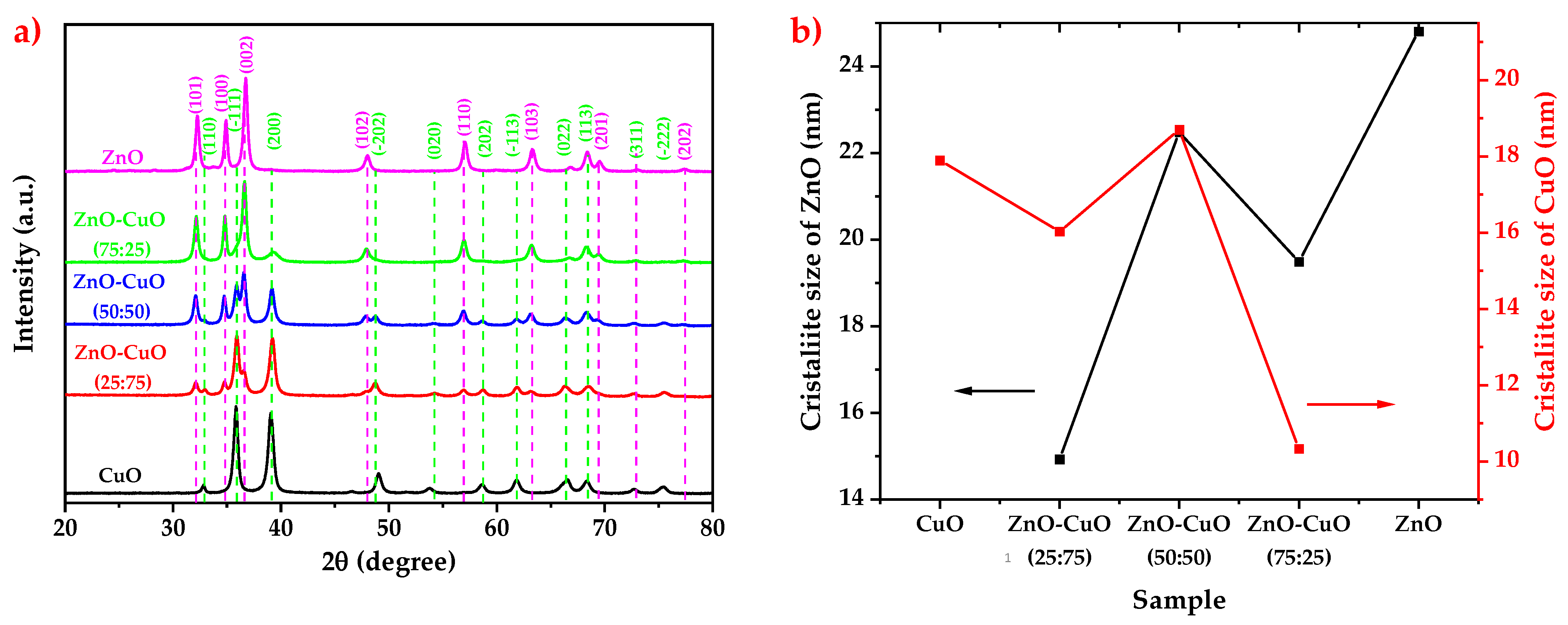
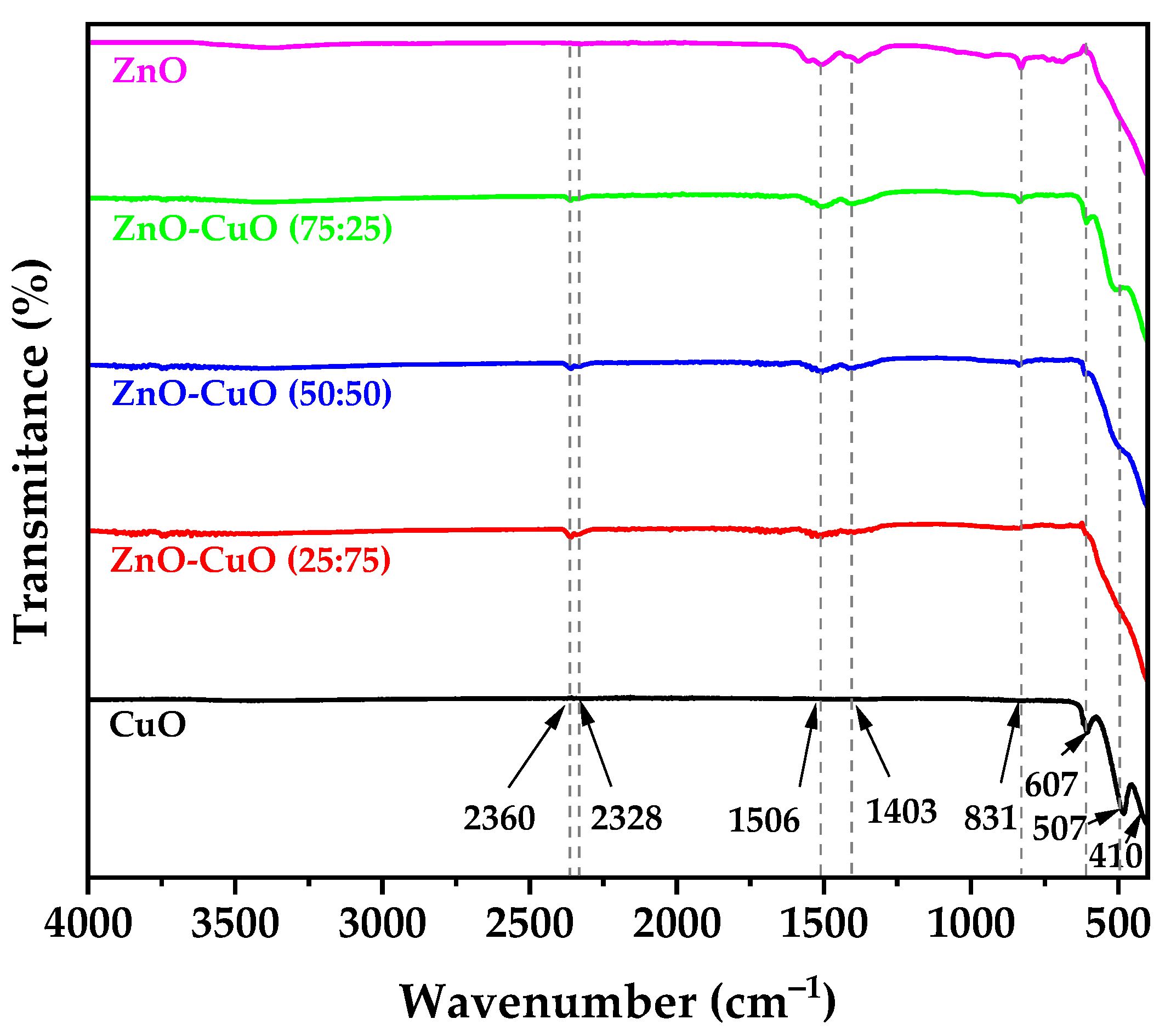
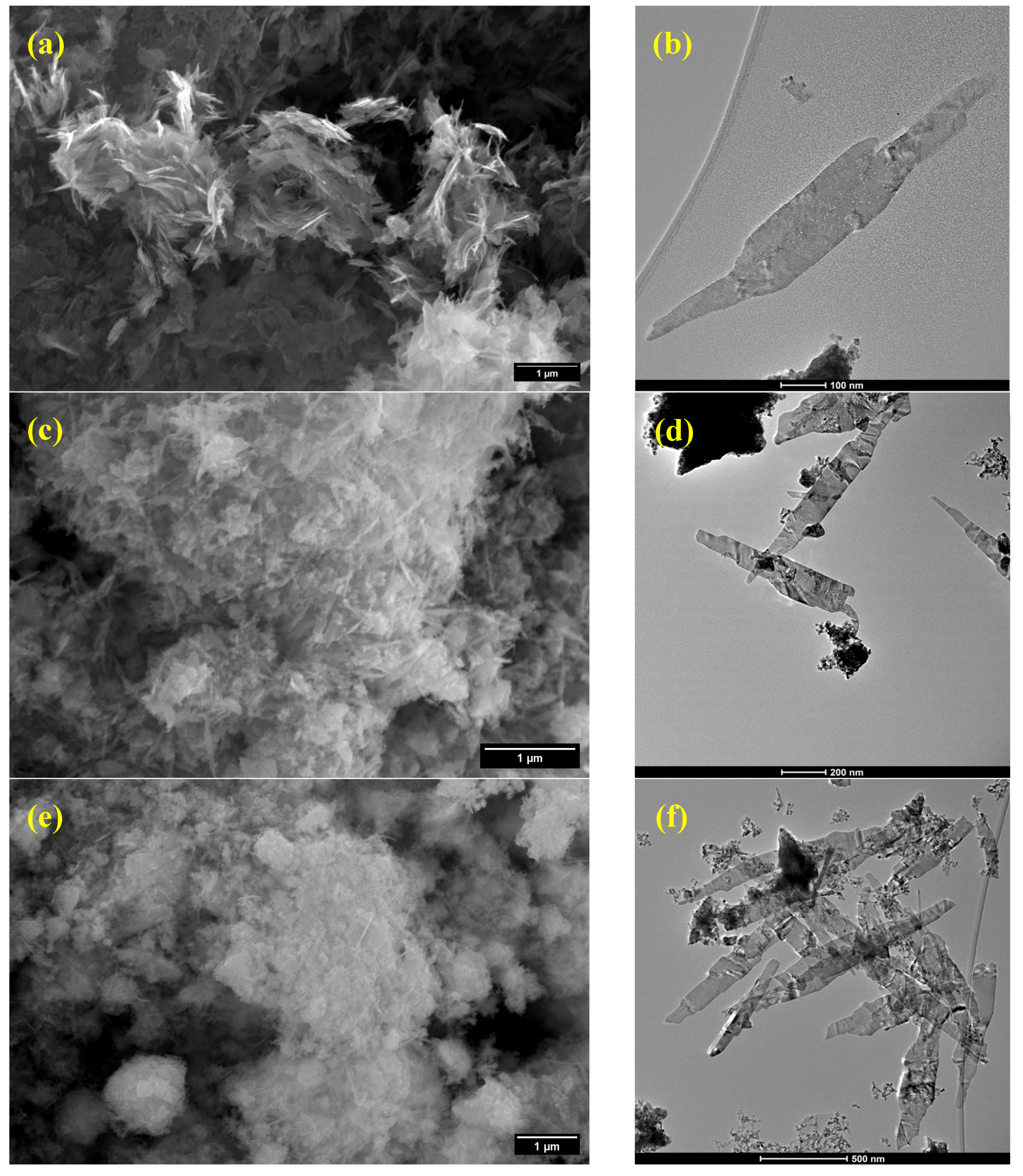
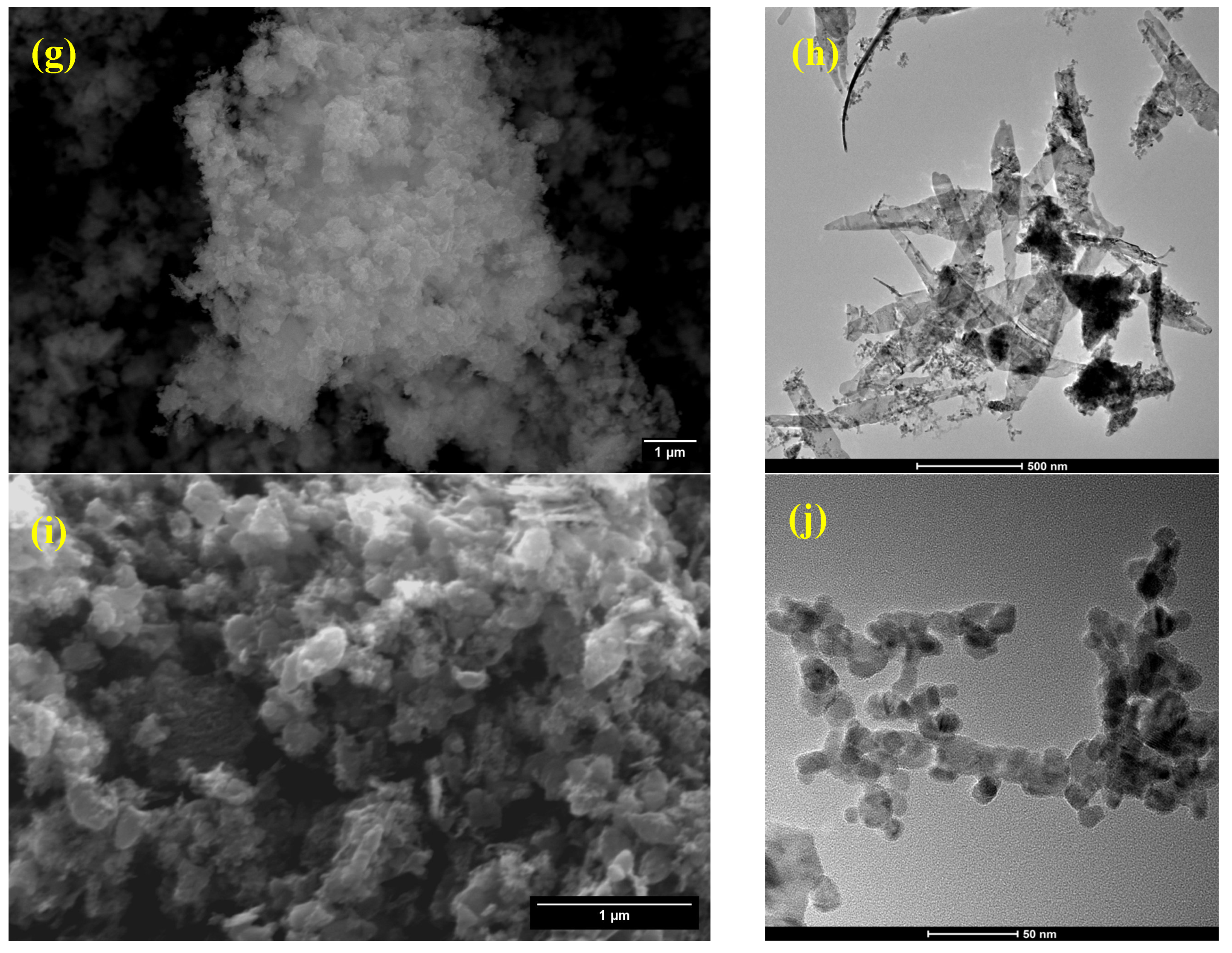
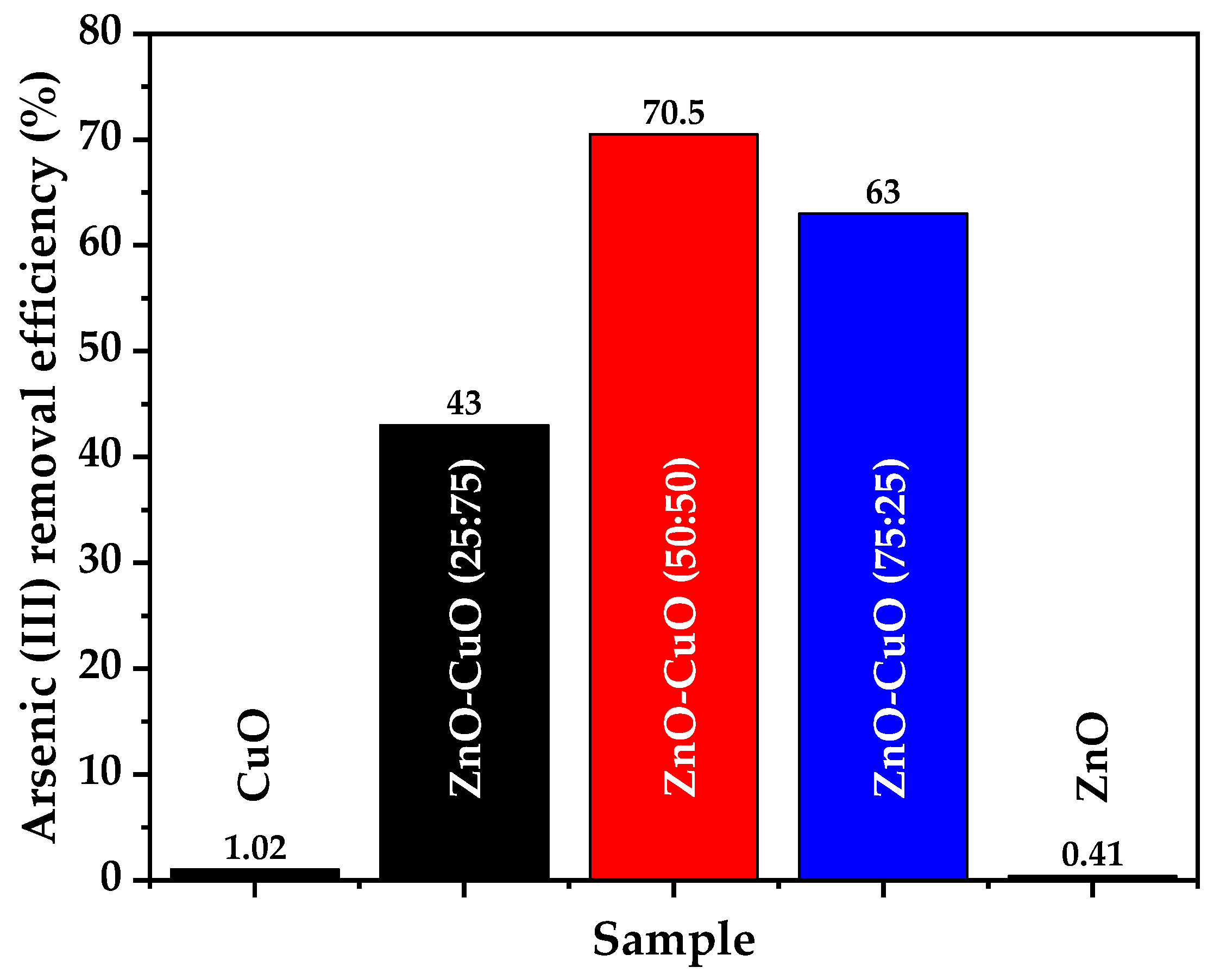
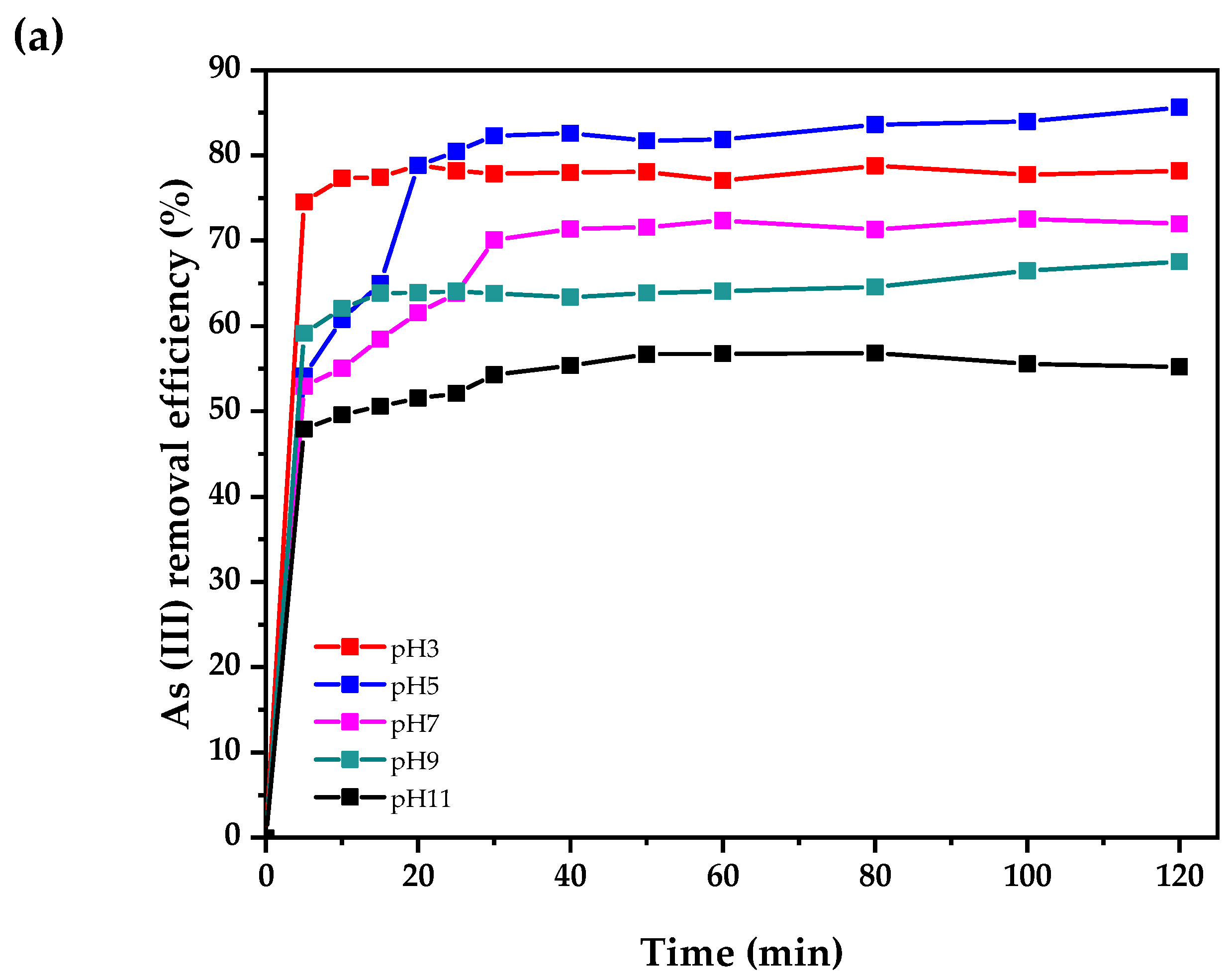
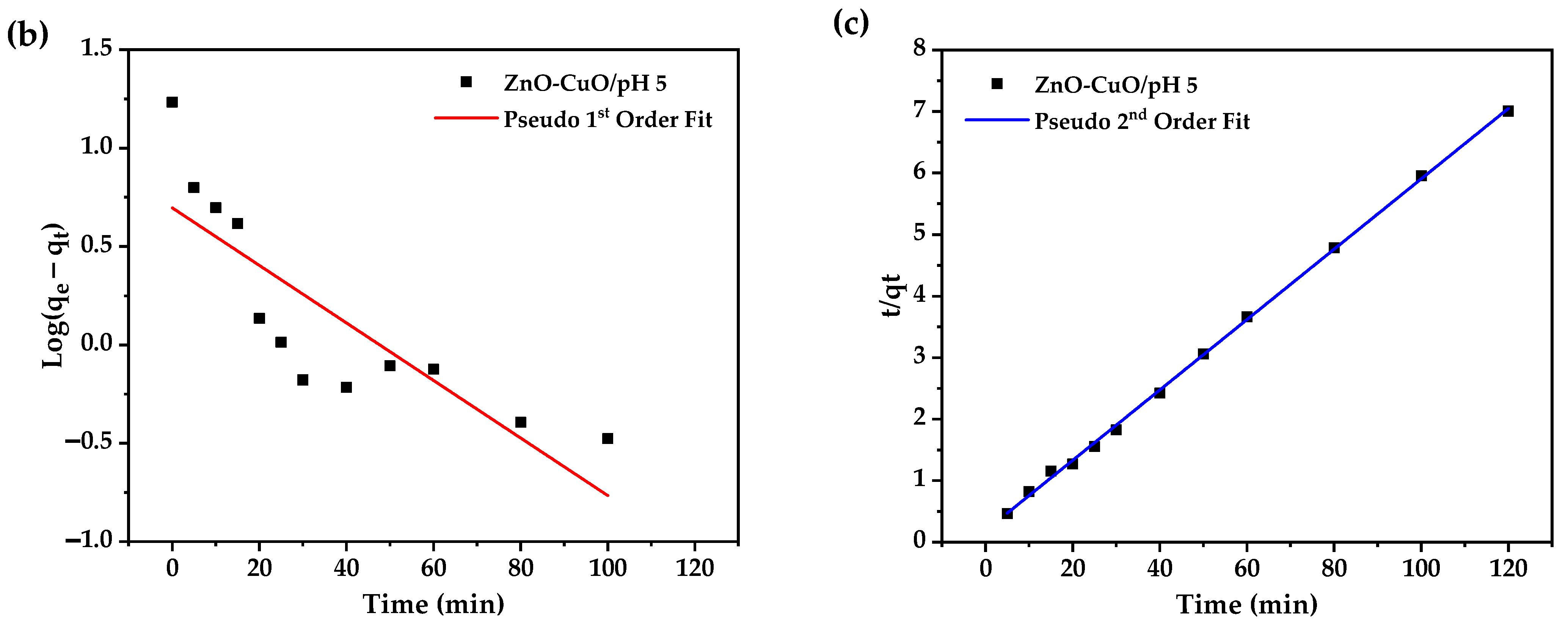
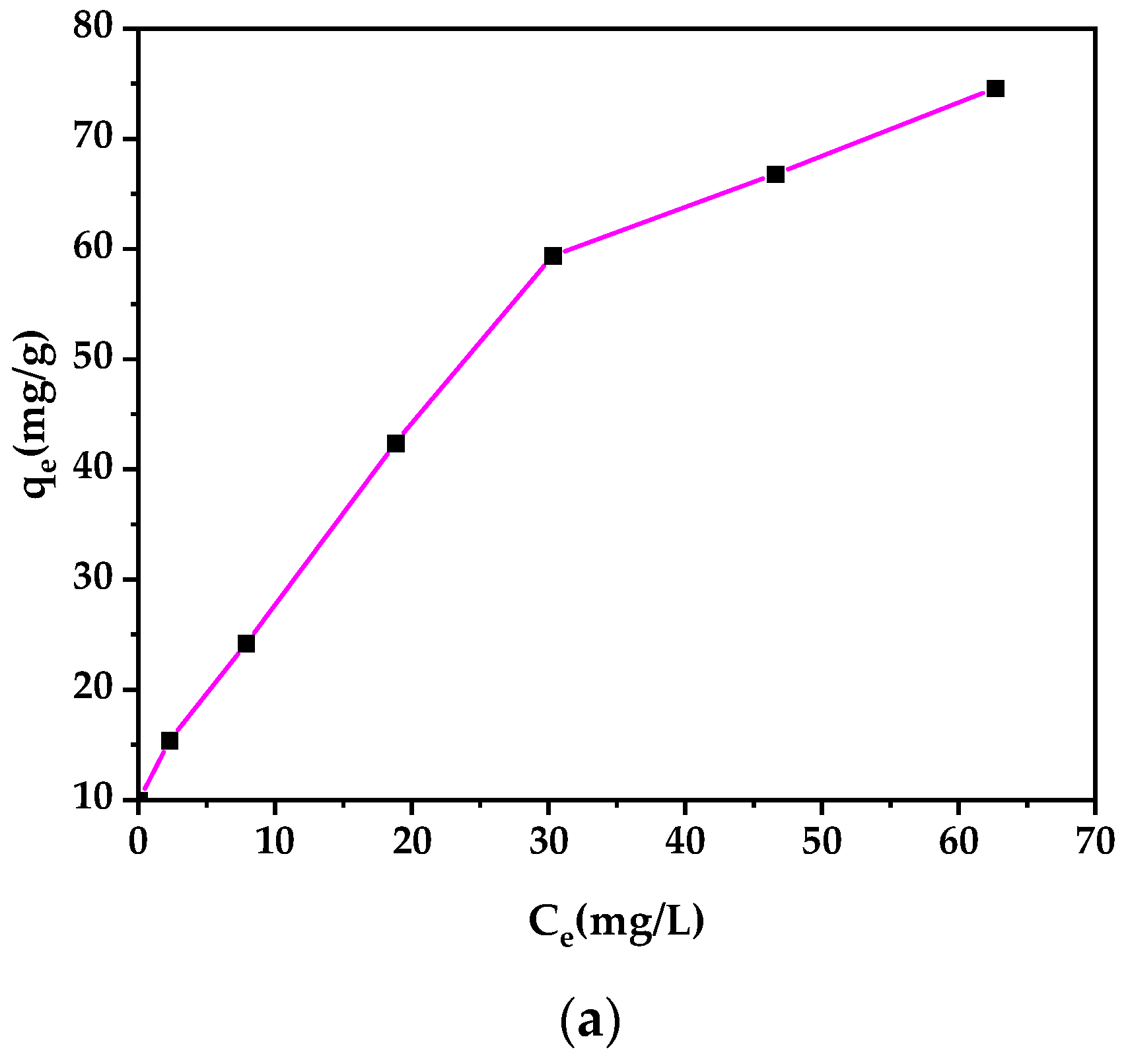

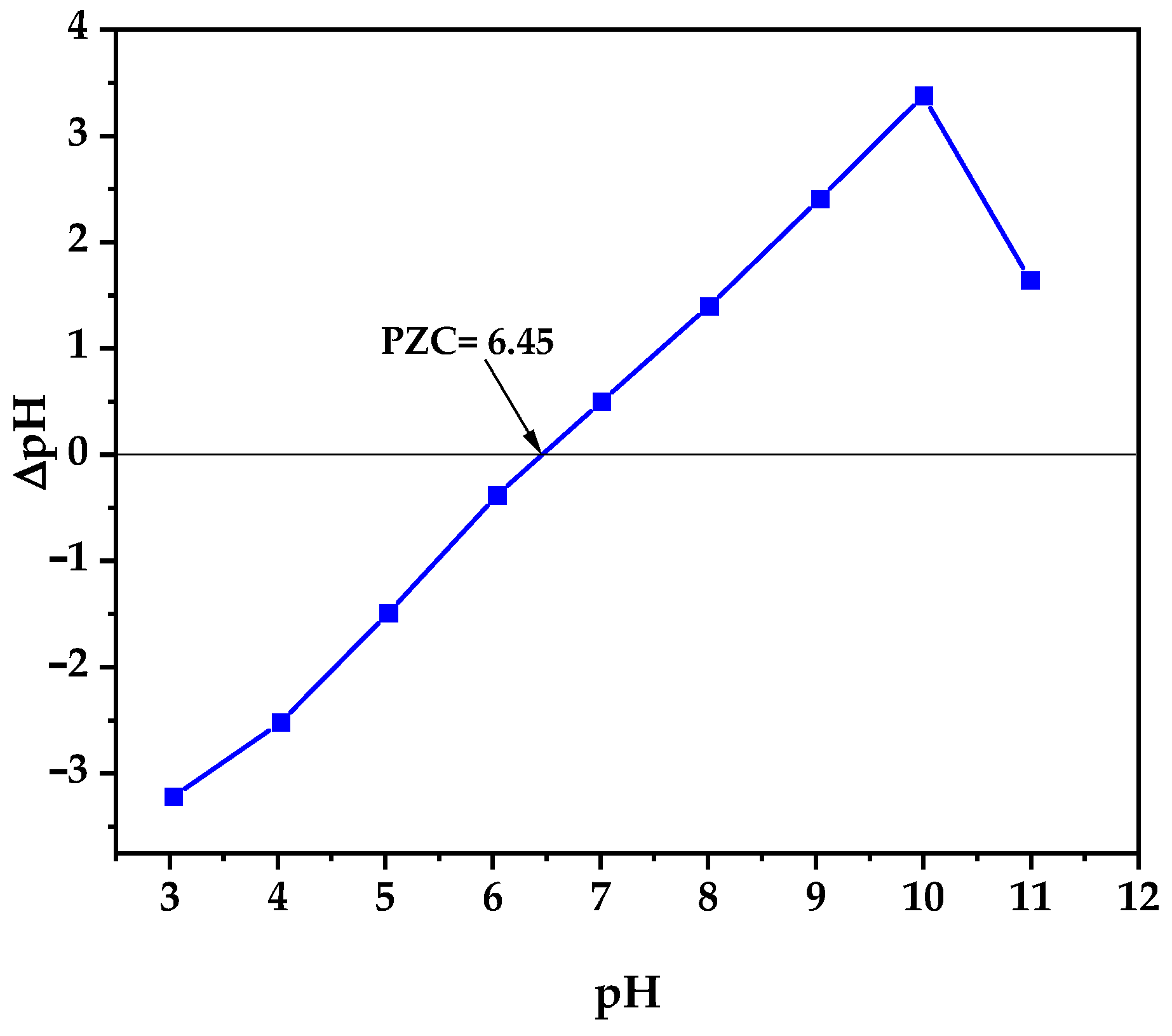
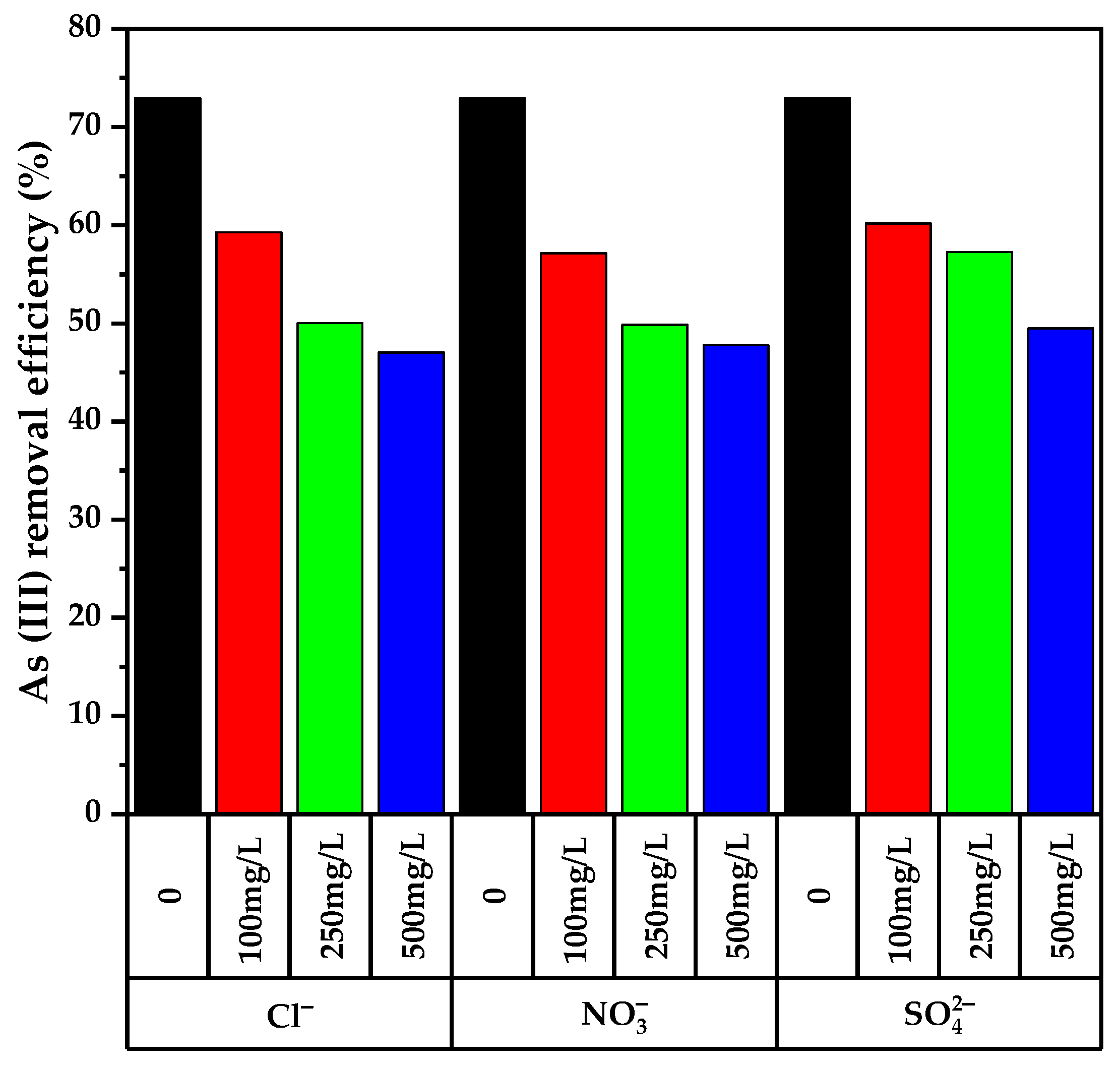
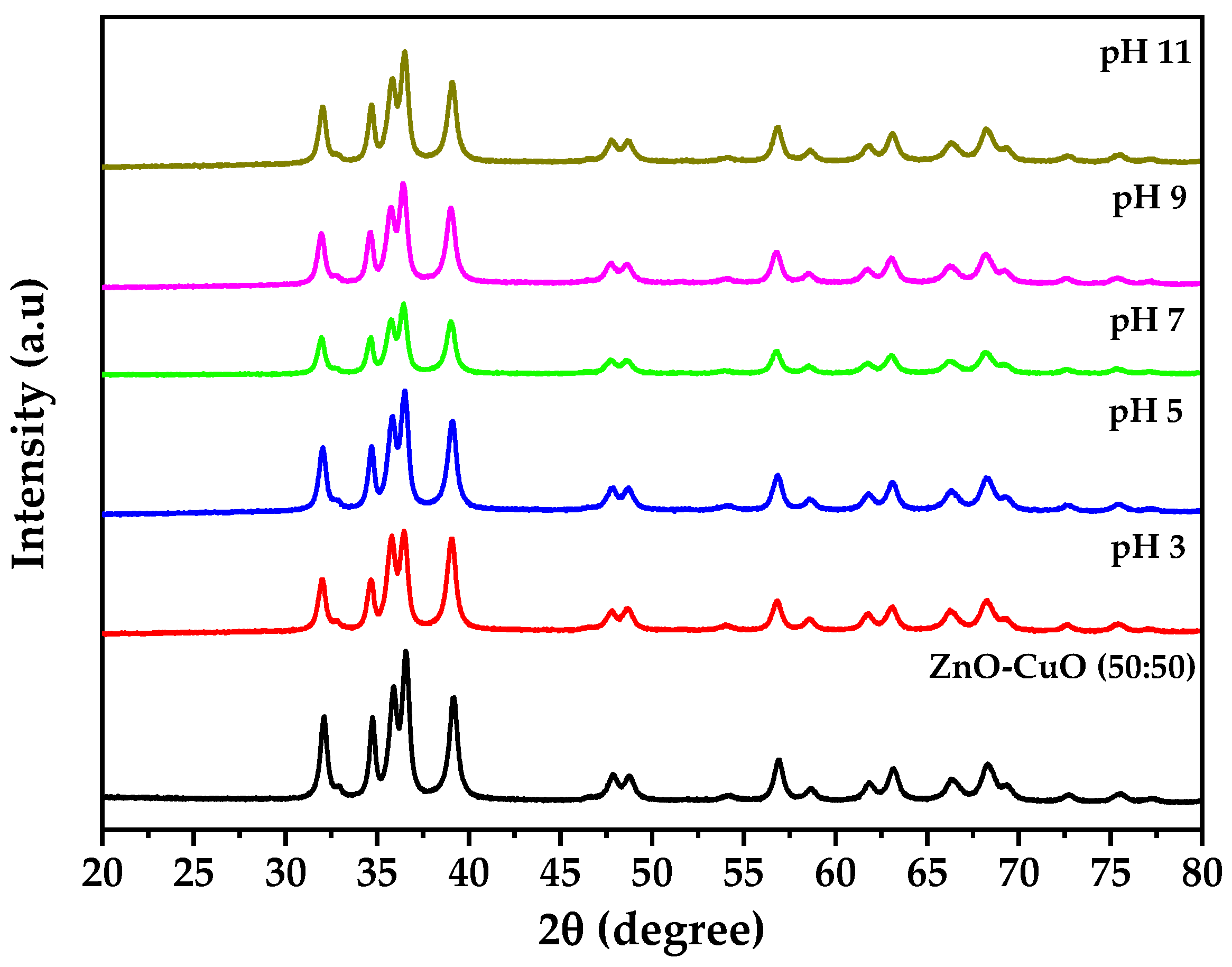
| Sample | CuO (100) | ZnO-CuO (25:75) | ZnO-CuO (50:50) | ZnO-CuO (75:25) | ZnO (100) | |||
|---|---|---|---|---|---|---|---|---|
| Phase | CuO | ZnO | CuO | ZnO | CuO | ZnO | CuO | ZnO |
| Crystal system | Monoclinic | Hexagonal | Monoclinic | Hexagonal | Monoclinic | Hexagonal | Monoclinic | Hexagonal |
| Phase percentage (%) | 100 | 24.71 | 75.29 | 48.57 | 51.43 | 75.2 | 24.8 | 100 |
| a (nm) | 4.67793 | 3.25339 | 4.72394 | 3.25317 | 4.71857 | 3.25237 | 4.76458 | 3.24885 |
| b (nm) | 3.42191 | 3.25339 | 3.40375 | 3.25317 | 3.40595 | 3.25237 | 3.3736 | 3.24885 |
| c (nm) | 5.12759 | 5.21114 | 5.1312 | 5.21158 | 5.13222 | 5.21043 | 5.1187 | 5.20628 |
| α (°) | 90 | 90 | 90 | 90 | 90 | 90 | 90 | 90 |
| β (°) | 99.49249 | 90 | 99.95483 | 90 | 99.88692 | 90 | 99.96167 | 90 |
| γ (°) | 90 | 120 | 90 | 120 | 90 | 120 | 90 | 120 |
| ρ (g/cm3) | 6.5 | 5.66 | 6.5 | 5.66 | 6.5 | 5.66 | 6.52 | 5.67 |
| D (nm) | 17.9 | 14.93 | 16.03 | 22.48 | 18.7 | 19.49 | 10.33 | 24.81 |
| Rexp (%) | 1.37993 | 1.32982 | 1.31176 | 1.32851 | 1.24266 | |||
| Rwp (%) | 2.23386 | 2.26934 | 2.24639 | 2.5136 | 2.16768 | |||
| Rp (%) | 1.74381 | 1.86191 | 1.96468 | 1.7781 | 1.58302 | |||
| GOF | 1.29957 | 1.31047 | 1.34613 | 1.25582 | 1.74439 | |||
| SSABET (m2/g) | 22.3098 ± 0.0625 m2/g | 21.8229 ± 0.0198 m2/g | 17.7192 ± 0.2239 m2/g | 19.5901 ± 0.1120 m2/g | 18.4638 ± 0.0642 m2/g | |||
| pH | Pseudo 1st Order | Pseudo 2nd Order | ||||
|---|---|---|---|---|---|---|
| k1 | qe | R2 | k2 | qe | R2 | |
| pH 3 | 0.01369084 | 1.19 | 0.60288 | 0.62686683 | 15.63 | 0.99991 |
| pH 5 | 0.00634824 | 2.01 | 0.70912 | 0.01764271 | 17.48 | 0.99918 |
| pH 7 | 0.02101172 | 3.36 | 0.85998 | 0.02300911 | 14.88 | 0.99959 |
| pH 9 | 0.01300043 | 2.30 | 0.54333 | 0.04975609 | 13.44 | 0.99909 |
| pH 11 | 0.02208858 | 2.18 | 0.98732 | 0.08071776 | 11.29 | 0.99925 |
| Isotherm Model | Nonlinear Form | Linear Form | Plot | References |
|---|---|---|---|---|
| Langmuir | [73] | |||
| Freundlich | [74] |
| Isotherm Model | Langmuir | Freundlich | |||||
|---|---|---|---|---|---|---|---|
| Parameters | qmax (mg/g) | KL | RL | R2 | Kf | 1/n | R2 |
| Value | 64.7668 | 0.1283 | 0.4380 | 0.9243 | 9.6168 | 0.2190 | 0.9856 |
Disclaimer/Publisher’s Note: The statements, opinions and data contained in all publications are solely those of the individual author(s) and contributor(s) and not of MDPI and/or the editor(s). MDPI and/or the editor(s) disclaim responsibility for any injury to people or property resulting from any ideas, methods, instructions or products referred to in the content. |
© 2023 by the authors. Licensee MDPI, Basel, Switzerland. This article is an open access article distributed under the terms and conditions of the Creative Commons Attribution (CC BY) license (https://creativecommons.org/licenses/by/4.0/).
Share and Cite
Medina Salas, J.P.; Gamarra Gómez, F.; Sacari Sacari, E.J.; Lanchipa Ramos, W.O.; Tamayo Calderón, R.M.; Mamani Flores, E.; Yapuchura Platero, V.; Florez Ponce de León, W.D.; Sandoval, E.M.L. ZnO-CuO Nanocomposite as an Efficient Adsorbent for As(III) Removal from Water. Water 2023, 15, 4318. https://doi.org/10.3390/w15244318
Medina Salas JP, Gamarra Gómez F, Sacari Sacari EJ, Lanchipa Ramos WO, Tamayo Calderón RM, Mamani Flores E, Yapuchura Platero V, Florez Ponce de León WD, Sandoval EML. ZnO-CuO Nanocomposite as an Efficient Adsorbent for As(III) Removal from Water. Water. 2023; 15(24):4318. https://doi.org/10.3390/w15244318
Chicago/Turabian StyleMedina Salas, Jesús Plácido, Francisco Gamarra Gómez, Elisban Juani Sacari Sacari, Wilson Orlando Lanchipa Ramos, Rocío María Tamayo Calderón, Efracio Mamani Flores, Víctor Yapuchura Platero, Walter Dimas Florez Ponce de León, and Elmer Marcial Limache Sandoval. 2023. "ZnO-CuO Nanocomposite as an Efficient Adsorbent for As(III) Removal from Water" Water 15, no. 24: 4318. https://doi.org/10.3390/w15244318
APA StyleMedina Salas, J. P., Gamarra Gómez, F., Sacari Sacari, E. J., Lanchipa Ramos, W. O., Tamayo Calderón, R. M., Mamani Flores, E., Yapuchura Platero, V., Florez Ponce de León, W. D., & Sandoval, E. M. L. (2023). ZnO-CuO Nanocomposite as an Efficient Adsorbent for As(III) Removal from Water. Water, 15(24), 4318. https://doi.org/10.3390/w15244318









